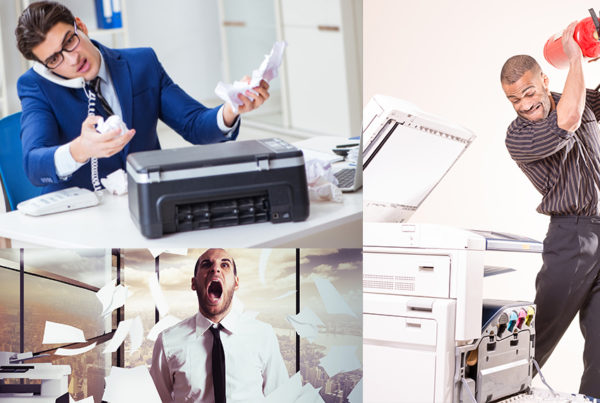Real-life offices aren’t like the television show “The Office.” Surely not. They are more logical and functional.
Right?
I’m sure many will clap back at this remark, and many will be right considering how every office is unique and every human being is unique.
But what is certainly dysfunctional like “The Office” is how many offices overlook sensible supply practices — which causes product waste, productivity waste, and environmental waste. That’s a lot of “wasted” opportunities, especially when it comes to printing (often the highest business cost behind rent and utilities).
So, let’s turn “The Office” reality into a distant fantasy by following these eco-friendly printing tips.
1. Create an office print policy
Ninety percent of offices, according to one study, don’t employ a formal print policy (and I’m sure that includes the television show). Just as bad, two-thirds of businesses don’t track printing expenses. And this is a world where management is commonly tasked to control the office thermostat and coffee consumption. Why not printing?
You can quickly craft a procedure that addresses issues like toner ordering guidelines, when to print in color, and where to store discarded printed documents. Just as good, you can alternatively download our Office Printing Policy.
2. Track your office printer usage
Having a print policy is awesome, but it’s only half the battle of not becoming “The Office.” You must optimize your printing environment. After all, U.S. companies spend more than $120 billion each year on printing at an average cost of $725 per person.
How do you track printer usage, though?
Beyond NSA-type surveillance, not desirable for any company that wants to keep its employees, printer monitoring can automatically and digitally track toner levels and every paper printed, offering concise metrics at the push of a button. These days, printer monitoring is safe and secure. Our printer monitoring is complimentary and with features to help your office become eco-friendly, but do your homework to see what’s out there.
3. Consider a managed print service
In this gig/digital economy, anything can be outsourced for profitable results. Why not your printing environment? Partnering with a provider of Managed Print Services (MPS) puts printer issues in the hands of a dedicated expert, allowing others in the office to focus on their jobs. What’s more, an effective managed print services can reduce business costs by 20-30 percent, not to mention increase network security and sustainability.
Like printer monitoring, our managed print services are no-cost, if you buy our printer products. We just really believe in our printer products.
4. Don’t just throw used print cartridges away
Most empty printer cartridges end up in the trash. This is partly why every year more than 375 million empty, nonbiodegradable, and often-toxic printer cartridges end up in landfills (and also consider the average worker prints 10,000 pages a year, which mostly don’t get recycled).
That’s grim news, especially considering that sustainability is actually positive for branding, employee happiness, and business growth.
At Cartridge World, we help offices become eco-friendly with several green initiatives, and you can find ways to print greener with our Green Office Printing Guide. The key is to do something about instilling sustainability practices in your office.
By doing something, I would not recommend like in “The Office”:

5. Leverage energy-saving mode for your printers
While we’re on the eco-friendly, saving energy is saving money and your community. Printers are electricity black holes. Printer power consumption can account for up to seven percent of an organization’s total electricity consumption — even if only 15 percent of printer electricity usage is attributed to printing!
Turn your printers off at the end of the day and during business hours, and for all electronics, don’t confuse a screen saver for sleep mode. Power is still draining. Ensure computers switch to sleep mode when inactive for some time, and this goes as well for printers, monitors, and other office equipment.
6. Take advantage of print driver default settings to save costs
Most of today’s printer drivers have neat default setting options to help your office save costs. A popular default setting to save on toner cartridges is printing in black and white/draft mode instead of high-quality (reasonable to execute if a document is just for internal use).
Setting driver defaults is easy, even for characters in “The Office.”
7. Know what printer should do what
If you have several printers, think of them as team members with their own skills. Typically, the more expensive the printer, the cheaper the cost per page to print. Small desk jet printers are more suited for color documents, but when it comes to plain old black and white, they tend to cost 5 to 20 times more than printing on a bigger device.
Let your monster printers in the office do the monster printing, while the small guy can take care of more “artsy” documents.
8. Load Paper Right
But it’s just paper!
That’s true, but a mosquito at night while you’re trying to sleep becomes more than just an “insect.” Poorly loaded paper may result in (*drum roll*) paper jams! Most reams of paper make it extremely easy for people to understand how to properly load the printer, such as including an arrow on the packaging to instruct which way is up.
Just ask any character in “The Office” on the importance of paper, since it’s set in a fictional paper sales company, Dunder Mifflin Paper Company, Inc.
Watch our video below to see how to load paper.
9. Spruce your printer
Maybe printers are not as attractive as new sports cars, but they do require a bit of TLC to last. No need for intense Karate Kid “wax on, wax off.” By just giving your printing devices regular cleaning and maintenance, your office could be more eco-friendlier.
Spring home office cleaning presents a good opportunity to tune up printers.
Here’s a simple procedure:
After you’ve unplugged your printer, wipe down the exterior of the printer with a damp cloth to remove dust. Open your printer and employ a soft, microfiber cloth and isopropyl alcohol solution to clean the interior. Do not use compressed air, as this will push the debris to places you will be unable to reach.
Many printers also have an auto-clean setting for their print heads, so take advantage of that.
Ever had streaks appear on your documents? Here is what to do about it:
10. Watch out for those low toner warnings
The truth is that after a toner warning light comes up, many printer cartridges still have up to 25 percent toner in the tank. This could equate to an extra 400-500 pages if you keep that same cartridge. It’s always great to have cartridge or toner backups, but drain your current cartridge all the way, baby.
With these office supply practices, centering on printing, you’ll be less like “The Office” and more like “Mad Men.” And beyond better sustainability and productivity, your office will have more funds for pizza parties and the softball league. That’s no sitcom.
Looking to green your office and save on printing costs? Contact us for our various solutions that meet every business and budget.







